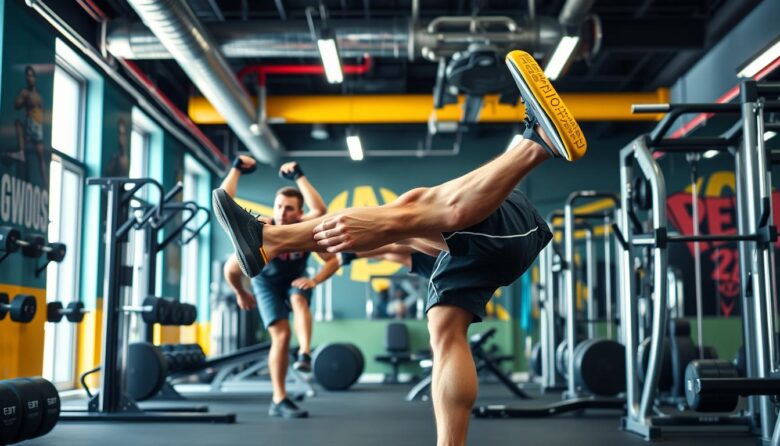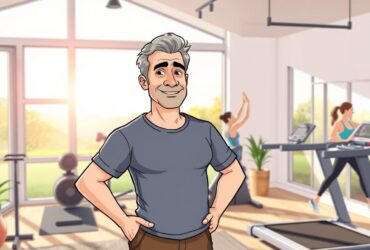As we get older, keeping our muscles strong is key. Leg muscles are among the biggest in our body. For men over 40, working out the lower body is vital. It helps keep muscles toned, improves movement, and prevents injuries.
These exercises do more than just make legs strong. They also support the nervous system, improve core stability, and boost balance.
Compound leg exercises target many muscles at once. This helps burn calories and supports fitness goals. Squats, lunges, and deadlifts work the biggest muscle groups. They help manage weight and improve blood flow to the legs.
This article will cover how to strengthen the lower body for men over 40. We’ll look at effective exercises, safety tips, and how to progress. Understanding the benefits of leg workouts will help you add them to your routine. This will improve muscle mass, enhance function, and make you feel stronger and more confident.
Understanding Age-Related Changes in Leg Muscles
Men in their 40s and beyond often see a quick drop in lower body strength and mobility. This is mainly due to changes in their leg muscles with age. Knowing these changes is key to creating a good workout plan for this age group.
Hormonal Changes and Muscle Mass
Testosterone levels play a big role in muscle loss, or sarcopenia, in older men. By age 65, about 60% of men have lower testosterone than when they were younger. This hormone drop leads to less muscle, strength, and ability to make new proteins.
Impact on Joint Health and Mobility
Changes in leg muscles also affect joints and how well you move. With less muscle and strength, joints are more at risk for injury. Also, losing muscle can make you less flexible and balanced, raising the chance of falls.
Recovery Considerations After 40
As men get older, they need more time to recover between workouts. Older people take longer to fix and grow back muscle. This means they need to adjust how often and how hard they work out to avoid overdoing it and not recover well.
Understanding these changes helps men over 40 create a strong lower body strength training plan. This plan can help them stay physically strong and keep their joint health as they age.
Benefits of Lower Body Training for Mature Men
As men get older, keeping their lower body strong is key. Regular workouts in this area bring many benefits. They help improve life quality, boost metabolism, and enhance bone density. They also improve functional fitness, which is vital for health and wellness.
Lower body training fights muscle loss that comes with age. It works the big muscles in the legs. This helps keep or even grow muscle, which is crucial for staying mobile and balanced as we age.
Strong legs also help the heart. The big muscles in the legs need a lot of oxygen and energy. This boosts metabolism and helps manage weight, lowering risks of heart disease and diabetes.
- Improved bone density and reduced risk of osteoporosis
- Enhanced functional fitness for daily activities and sports
- Alleviation of lower back pain and better overall posture
- Increased testosterone levels and improved sexual function
Adding lower body strength training to your fitness routine can change your life. It brings many benefits that support health, energy, and independence in the later years.

Essential Equipment and Safety Precautions
Starting a lower body strength training plan as a man over 40 needs the right tools and safety steps. This ensures your workouts are effective and safe. Using resistance bands and dumbbells can greatly impact your fitness journey.
Proper Warm-up Techniques
Before starting your lower body exercises, a good warm-up is key. It prepares your muscles and joints for the workout. Include dynamic stretches, light cardio, and mobility exercises to get your body ready.
Spending 5-10 minutes on a proper warm-up can prevent injuries and improve your performance.
Equipment Selection Guide
- Resistance bands: Versatile and low-impact, resistance bands can target specific muscle groups and help build strength.
- Dumbbells: Adjustable in weight, dumbbells allow for targeted muscle isolation and controlled movements.
- Barbells: For compound exercises like squats and deadlifts, barbells provide a stable and challenging option.
- Weight machines: These guided movements can be a good option for beginners or those recovering from injuries.
Form and Technique Tips
Keeping proper form and technique is crucial when doing lower body exercises. Start with lighter weights and gradually increase the intensity. This ensures you’re doing the movements right and avoiding injuries.
Listen to your body and don’t be afraid to ask for help from a certified personal trainer or physical therapist.
By focusing on the right equipment and following safety guidelines, you can start your lower body strength training with confidence. Remember, investing time in proper preparation and technique will lead to better results and a healthier body.
Lower Body Strength Fundamentals
As men get older, keeping their lower body strong is key. Compound exercises are vital for this. They work many muscles at once. Squats, lunges, deadlifts, and step-ups are essential for a strong lower body.
Getting the right muscles to work is crucial. Focus on controlled movements and proper form. This helps your leg muscles work well, lowers injury risk, and aids in long-term progress.
Progressive overload is a must for any strength program. It means adding more weight, reps, or sets over time. This keeps your muscles growing stronger. It’s how you see steady gains in strength and power.
Whether you’re experienced or new to strength training, knowing these basics is important. They help you reach your fitness goals and stay physically fit as you age.

Core Exercises for Leg Power and Stability
Men over 40 need to keep their leg power and stability up. Core exercises are key for this. They boost strength, prevent back pain, and improve posture. Adding core workouts to your routine can make your lower body exercises better.
Squats and Variations
The squat is a basic exercise that works the core. Goblet squats and front squats challenge the core more. They work many leg muscles and strengthen the core for better power and stability.
Lunges and Step-ups
Lunges and step-ups are great for leg power and stability. They need balance and coordination, making the core work harder. Adding these to your routine boosts lower body strength and fitness.
Deadlift Techniques
The deadlift works the legs, hips, and back. Using the right deadlift techniques strengthens the legs and engages the core. This improves lower body strength and stability.
| Exercise | Targeted Muscle Groups | Core Benefits |
|---|---|---|
| Squat (including variations) | Quadriceps, Glutes, Hamstrings | Improved core strength and stability |
| Lunge (including variations) | Quadriceps, Glutes, Hamstrings | Enhanced leg power and stability |
| Deadlift (including variations) | Posterior Chain (Hamstrings, Glutes, Back) | Strengthened core strength and leg power |
Adding core exercises to your routine can greatly improve strength and stability. Focus on core strength, leg power, and proper technique. This will help you stay strong and active as you age.
Progressive Training Methods for Aging Muscles
Men in their 40s and beyond face changes that affect their muscle strength and fitness. But, there are ways to fight these changes and keep muscles healthy.
Periodization is key for older men. It involves changing training phases like strength, power, and hypertrophy. This helps avoid plateaus and overtraining. Changing rep ranges, using tempo training, and adjusting rest times also aid in muscle growth.
Also, older men might need to train less often. Younger men can handle more frequent workouts, but older men should pace themselves. This prevents too much fatigue and injury.
It’s also important to add exercises that boost flexibility and mobility. This keeps men over 40 fit and injury-free. By focusing on these areas, muscles can keep adapting and performing well with age.
- Use periodization to switch between different training phases.
- Change rep ranges, add tempo training, and adjust rest times for muscle growth.
- Adjust how often you train to ensure enough recovery time.
- Add exercises that improve flexibility and mobility to stay fit and injury-free.
By using these progressive training methods, men over 40 can keep their muscle strength up. They can also stay fit and enjoy a better quality of life as they age.
Recovery and Injury Prevention Strategies
Men over 40 doing lower body strength training need to focus on recovery and injury prevention. Using active recovery methods like light cardio or yoga can help. It reduces muscle soreness and boosts blood flow. Also, eating right is key for joint health. Focus on anti-inflammatory foods and supplements that help cartilage and connective tissue.
Active Recovery Methods
Doing mobility work like stretching and foam rolling keeps you flexible and lowers injury risk. Low-impact activities like walking, cycling, or swimming aid in recovery. They also improve your overall health.
Nutrition for Joint Health
Eating a balanced, anti-inflammatory diet is important for joint health. Include foods rich in omega-3s, antioxidants, and collagen-boosters. Supplements like glucosamine, chondroitin, and turmeric can also offer joint support.
Mobility Work Integration
Adding dynamic stretches, foam rolling, and other mobility exercises to your routine is beneficial. They help keep your range of motion good, improve muscle function, and lower injury risk. Spending time on these activities can greatly improve your recovery and injury prevention.
Getting enough sleep, managing stress, and taking a holistic approach to health are also crucial. They are key for mature men doing lower body strength training.
Conclusion
Keeping lower body strength up is key for men over 40. It helps keep muscle mass, boosts mobility, and improves life quality. Understanding muscle changes with age and using the right training methods are crucial. This way, men can keep their leg strength up as they get older.
Working out the lower body regularly helps with balance, metabolism, and functional fitness. It supports a healthy, active life. With hard work and the right advice, men over 40 can see big gains in leg strength. This supports their fitness goals for life.
The secret to strong legs for older men is a well-rounded approach. It must meet their specific needs and challenges. By staying informed and committed, men over 40 can enjoy strong legs. This keeps them physically strong and independent for many years.










